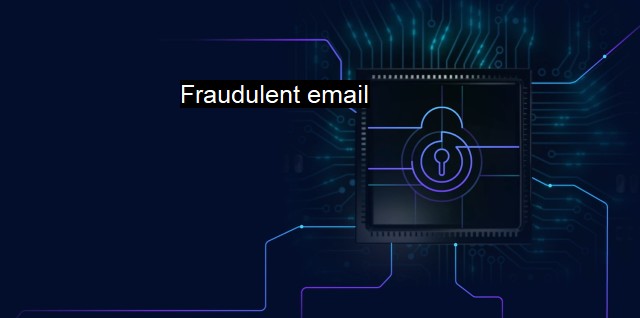What is Fraudulent email?
Phishing Emails: Understanding the Growing Threat of Frauds and their Varied Forms in Cybersecurity
Fraudulent email, often termed as email fraud, is a significant concern in the field of cybersecurity today. This form of malevolent digital communication involves the practice of sending deceptive emails with the intent to defraud recipients either through identity theft, financial scams, or spreading of malicious software, including viruses. Combating these fraudulent or phish emails necessitates both robust antivirus software and a proclivity towards secure online behavior.Without a solid understanding of how fraudulent emails work, recognizing one could be undeniably challenging. Although these emails can come in various forms, they commonly employ social engineering methods. This technique manipulates human psychology, convincing innocent individuals to click on tricky links or enter personal data in forged web pages mimicking authentic sites. Phishing emails, business email compromise (BEC), counterfeit emails, spam emails, CEO frauds, "forward this email" scams, mailbox mining, and cloning are some of the well-known types of fraudulent emails.
In business email compromises (BEC), fraudsters impersonate authoritative organizational figures or business partners. Under the disguise of these costumes, scammers deceive employees to make wire transfer to bogus accounts. Counterfeit emails, conversely, leverage fake correspondences carrying payloads like malicious attachments or links. As regards spam emails, even though not all spam emails are deceitful, their volume brings them under this umbrella since some could carry fraudulent intentions. CEO frauds deceive employees falsely assuming they received emails from the top management whereas mailbox mining hackers subtly configure one's email account to forward/send fraudulent emails from their account.
The security risk and outcome associated with falling prey to a fraudulent email run the gamut from identity theft to financial loss, legal consequences, loss of confidentiality, damaging digital assets, and even sabotaging the brand image. With identity theft, nefarious parties acquire victims' sensitive personal credentials and use them for illegal activities or to commit cybercrimes. Financial loss is witnessed when victims are hoodwinked into providing their online banking details or credit card information on false pretenses.
When electronic conversations are thought to be clandestine but are readily available to the one sending the deceptive email, privacy evaporates. Legal consequences are another formidable concern since the receiver or sender might unknowingly become part of illegal endeavors leading to potential litigation. In terms of damaging digital assets, altering and hijacking control of servers, networks, and databases is commonplace. Reputational harm could be the aftermath when customers, employees, or stakeholders discover that their data privacy has been overrun.
To counter these threats, an arsenal consisting of different layers of cybersecurity defenses is necessary. Utilizing advanced antivirus software systems that actively monitor incoming emails is just one part of the prevention strategy. These systems scrutinize the email messages' content for disguised URLs, phishing links, and malicious attachments. Bear in mind that antivirus software isn't a one-size-fits-all remedy against email fraud since these threats continue to evolve with attackers constantly modifying their approach. Education and awareness amongst user communities are crucial parallely, promoting secure behaviors like not clicking on fishy links or skeptical attachments, verifying the email address of the sender, and suspecting unsolicited requests for personal data.
Further, cybersecurity departments or personnel, as frontline defenders, need to enforce robust security policies, including firewalls, spam filters, data encryption, and password management, among others. User permissions and restrictions must be defined and updated periodically, limiting the risk of internal threats. Considering the evolving methods of scammers, advanced threat intelligence gathering, artificial intelligence-driven security analytics, and machine learning technologies are becoming increasingly relevant in identifying and mitigating such issues, ensuring protection against possible fraudulent email attacks.
To sum up, while willful attackers continue their fraudulent email schemes, carefully crafted cybersecurity strategies meshed with vigilant online behavior and state-of-the-art antivirus prevention systems remain our solitary hope of staying ahead in this cyber arms-race, fostering a safer cyber sphere.

Fraudulent email FAQs
What is a fraudulent email?
A fraudulent email is an unsolicited email that is sent with malicious intent. The purpose of such emails is to trick recipients into disclosing sensitive information or download malware onto their devices.How can I identify a fraudulent email?
Fraudulent emails often contain spelling or grammar mistakes, urgent requests for personal information, or suspicious links. Be wary of emails from unknown senders or those with generic greetings.What should I do if I receive a fraudulent email?
Do not respond to the email or click on any links or attachments. Instead, report the email to your organization's IT department or delete it immediately.What can I do to protect myself from fraudulent emails?
To protect yourself from fraudulent emails, you should use antivirus software, enable spam filters, and regularly update your device's operating system and applications. Additionally, be cautious when opening emails from unknown senders or those with suspicious subject lines.| | A | | | B | | | C | | | D | | | E | | | F | | | G | | | H | | | I | | | J | | | K | | | L | | | M | |
| | N | | | O | | | P | | | Q | | | R | | | S | | | T | | | U | | | V | | | W | | | X | | | Y | | | Z | |
| | 1 | | | 2 | | | 3 | | | 4 | | | 7 | | | 8 | | |||||||